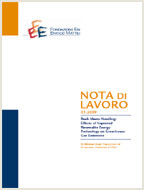Nautical Tourism, Carrying Capacity and Environmental Externality in the Lagoon of Marano and Grado

03.09.2013
Francesco Silvestri, Stefano Ghinoi, Vincenzo Barone
Q01, Q26, Q57
Tourism Carrying Capacity, Nature conservation, Externalities, Empirical studies
Climate Change and Sustainable Development
Carlo Carraro
Tourism and environmental preservation are often conflicting activities, mainly in areas such as coastal lagoons, where seaside mass-tourism comes into contact with a very sensitive ecological system. In this paper we deal with a classical problem of both environmental and tourism economics, the internalization of environmental costs of tourism, focusing on the nautical fruition of the Lagoon of Marano and Grado (North-Eastern Italy, Friuli Venezia Giulia Region). Using different instruments, both theoretical (Carrying Capacity framework, Polluter-Payer principle, Coase compensation) and empirical (Cluster analysis, Log-log regression, Forecasting model, cost and benefit calculation through actual market values), we get the result that a standard Coasian equilibrium (unit external cost equal to unit private benefit) doesn’t hold, and a higher coverage of the local berths endowment (i. e. a higher vessels transit in the Lagoon) is more effective for nature conservation than a tempered fruition. Another interesting result is that the best available solution to internalize environmental externality is a mixed one, comprehensive of a command and control rule (a speed-limit prescription), and a compensation scheme.
***
Suggested citation: Silvestri, F., S. Ghinoi, V. Barone (2013), ‘Nautical Tourism, Carrying Capacity and Environmental Externality in the Lagoon of Marano and Grado’, Economics and Policy of Energy and the Environment, Issue 3,2013.
